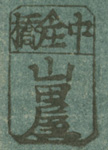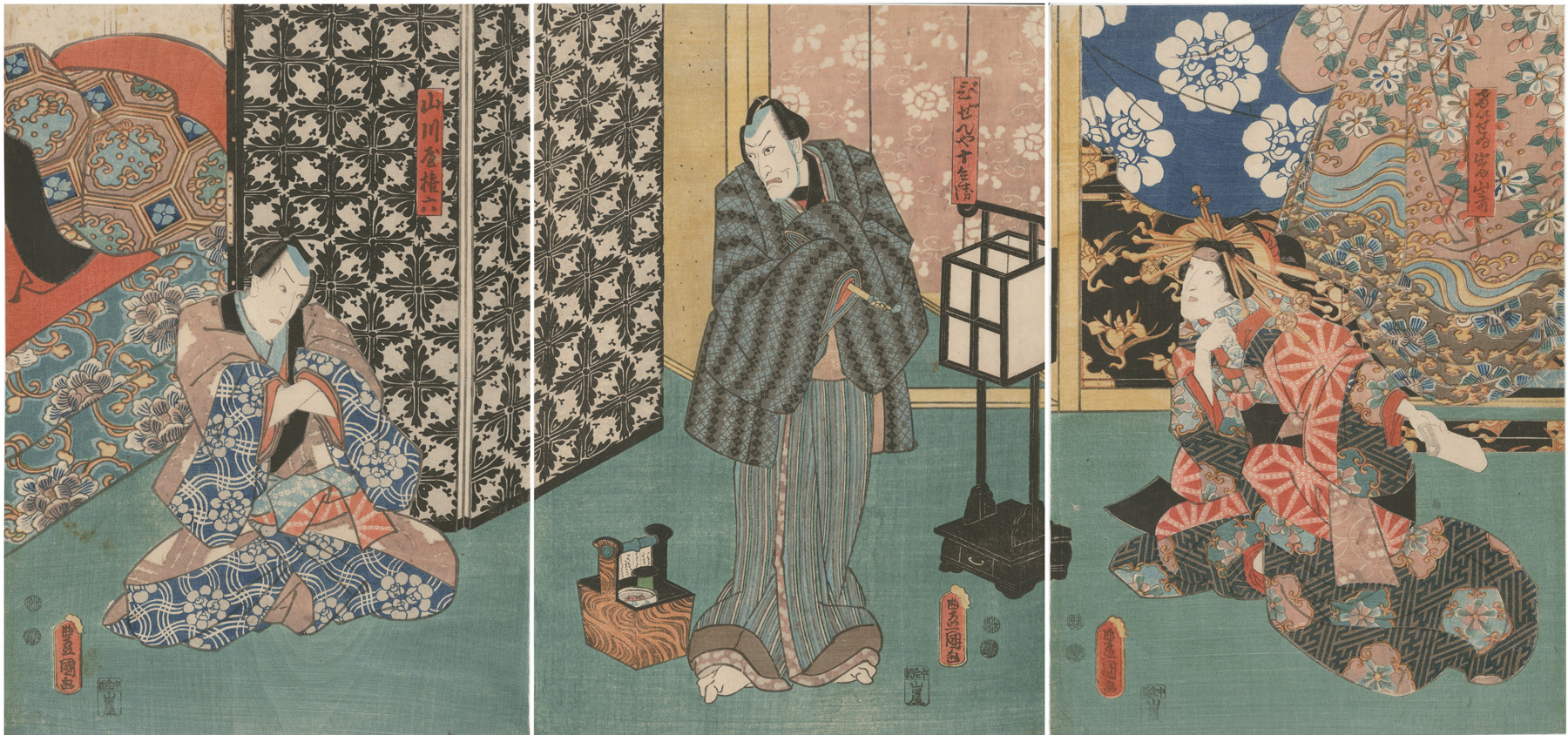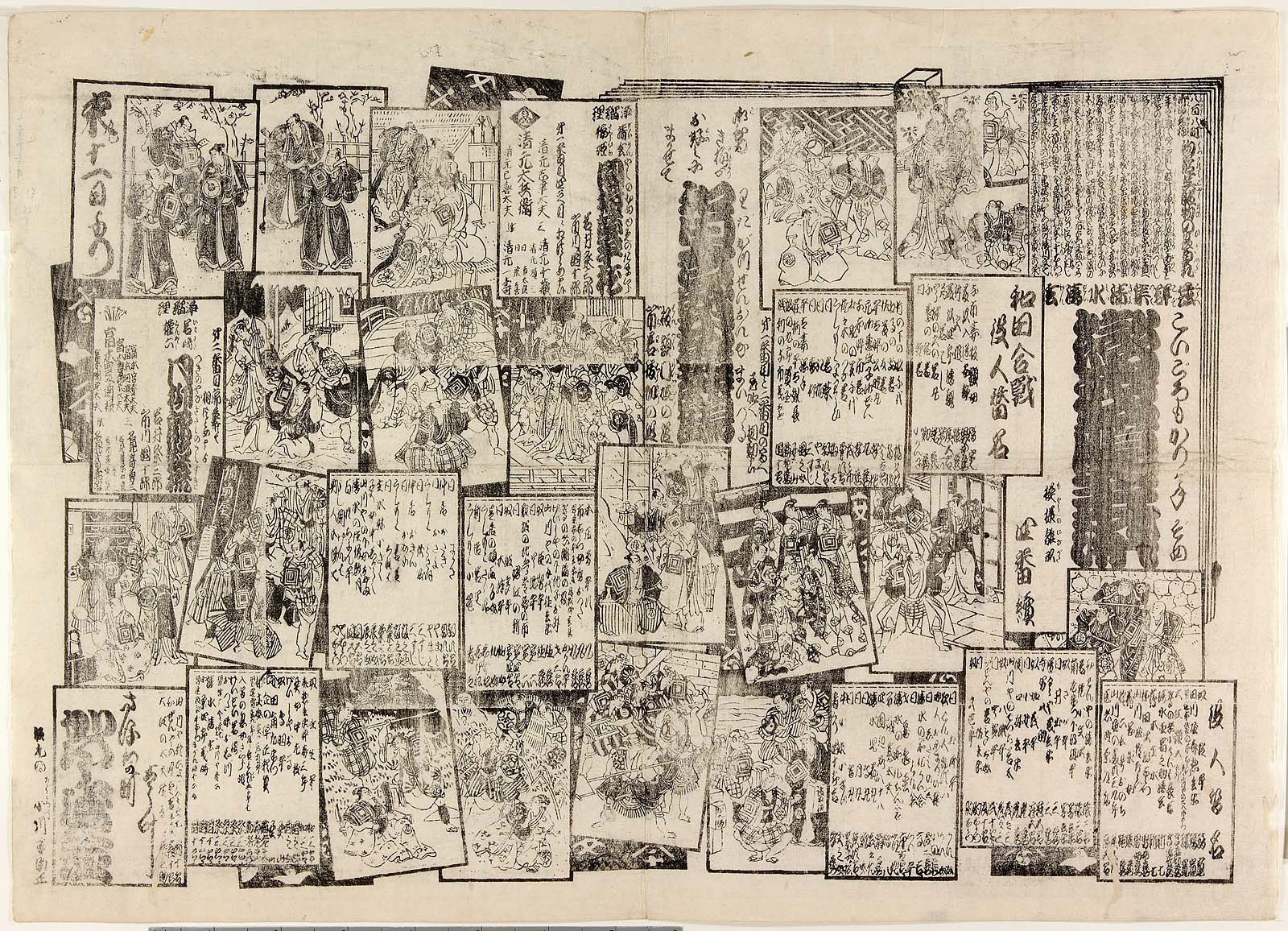About This Print
The actors (right to left) Iwai Kumesaburō III as the Courtesan (Keisei) Iwasaki, Ichikawa Ebizō V as Bizen'ya Jūbei (びぜんや) and Ichikawa Danjūrō VIII as Yamakawaya Gonroku (山川屋権六 )in a scene from the Kabuki play Koi goromo Karigane zome [恋衣雁金染(こいごろもかりがねそめ)], staged at the Kawarazaki theater during the first month of 1852.While only the actor's roles are provided on the print (within the orange cartouches) the website of the Museum of Fine Arts, Boston1 provides the actor's names and the title of the play. The museum also has the below Kabuki playbill (tsuji banzuke) in their collection, showing the three pieces that comprised the complete performance at the Nakamura-za from the 11th day of the 1st lunar month, 1852.
Tsuji banzuke2 for the kabuki dramas “Koigoromo karigane-zome”, “Wada gassen onna maizuru”,
“Yami no ume yume no tamakura” and “Tsuki no yanagi sato no kamisuki”.
These were performed at the Kawarazaki Theater (Edo) from the 11th day of the 1st lunar month of Kaei 5 (1852).
Published by Ogawa Hansuke.
The Play "Koi goromo Karigane zome"
The play Koi goromo Karigane zone, written by playwright Kawatake Mokuami (1816-1893), is based on the story Five Men of Naniwa, about five real-life outlaws who prayed on the residents of Osaka at the turn of the eighteenth century and who were eventually tried and executed in 1702.While a number of kabuki plays had previously used the Five Men of Naniwa as the basis for their script, Koi goromo Karigane zome "added captivating new twists to the way events unfolded" and left audiences gasping as the five outlaws were executed for killing the samurai Noda Kakuzaemon. In a twist from the real story, the five outlaws are seen as heroes for killing the evil Noda and their punishment is portrayed as an injustice visited upon them by the authorities.3
The Actors Pictured in This Collection's Print
For profiles of the actors depicted in this print please see the article The Kabuki Actor.
The Actors Pictured in This Collection's Print
For profiles of the actors depicted in this print please see the article The Kabuki Actor.1 Their prints 11.44024a-c, 11.45008a-c
2Tsuji banzuke are also called "below the turret banzuke" (櫓下番付), indicating that they developed from the placards placed in front of theatres to announce an on-going production. To the right is the title of the first piece on the program, while below the names of the actors and their characters run from right to left in order of importance. [source: Japanese Performing Arts Resource Center http://www.glopad.org/jparc/?q=en/prints/home
3 The Merchant's Capital of Early Modern Japan, James L. MacClain and Wakita Osamu, Cornell University Press, 1999, p. 145.
Print Details
| IHL Catalog | #1185 |
| Title (Description) | The actors Iwai Kumesaburō III as the Courtesan (Keisei) Iwasaki , Ichikawa Ebizō V and Ichikawa Danjūrō VIII (in a scene from Koi goromo Karigane zome 恋衣雁金染) |
| Series | n/a |
| Artist | Utagawa Kunisada I (1786–1865) |
| Signature |  |
| Seal | |
| Publication Date |  censor seals of Mera 米良 and Watanabe 渡辺 |
| Publisher |  [Marks pub. ref. 586; seal no. 21-138] |
| Carver | |
| Impression | excellent |
| Colors | excellent |
| Condition | good - light wrinkling throughout; some paper thinning verso from backing removal |
| Genre | ukiyo-e; yakusha-e |
| Miscellaneous | |
| Format | oban triptych |
| H x W Paper | 13 7/8 x 9 7/8 (35.2 x 24.1 cm) right sheet; 14 x 9 7/8 in. (35.6 x 25.1 cm) center sheet; 13 7/8 x 9 11/16 in. (35.6 x 24.6 cm) left sheet |
| Collections This Print | Museum of Fine Arts, Boston 11.44024a-c, 11.45008a-c |
| Reference Literature | |



